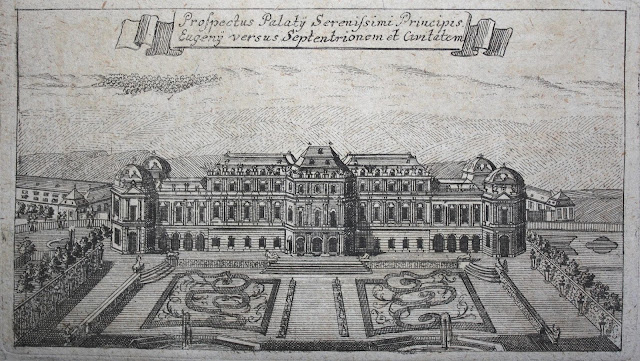In the penultimate part of the Vienna Travel series we visit the Belvedere Castle. It's a actually not a single castle, but a complex that consists of upper Belvedere, the Orangery and Palace Stables, as well as the lower Belvedere. Of course we took a stroll through all three parts of this complex, and now I want to share those images and stories with you. The design of the gardens and outer structures is very intricate and well planed.
A side note: the weather on this day was very mixed, and changed quickly, that's why the look of the images is not uniformed, since one minute the sky was clear and in the next one clouds rolled in again.
After we visited the Belvedere Castle we went for lunch and further sightseeing, and I have included those images in this post as well.
This is a multi-part travel series. Other parts include
Part One: Museum Quarter and Hofburg Palace
Part Two: Inner City and Horse carriages
Part Three: Graben, Stepahnsplatz and Metro
Part Four: Alpine Gardens
Part Five: Belvedere Castle
Part Six: Schönbrunn Palace
click on the images for a bigger view
The Belvedere was built during a period of extensive construction in Vienna, which at the time was both the imperial capital and home to the ruling Habsburg dynasty. This period of prosperity followed on from the commander-in-chief Prince Eugene of Savoy's successful conclusion of a series of wars against the Ottoman Empire.
When you enter the complex from the north you will first see the Upper Belvedere. The construction of the Upper Belvedere began as early as 1717, as testified by two letters that Prince Eugene sent from Belgrade to his servant Benedetti in summer 1718, describing the progress of work on the palace.
Belvedere Castle, engraving c. 1753
Through a side gate you can enter into the central gardens and make your way to the Lower Belvedere.
The Lower Belvedere and the Orangery have been specially adapted to stage special exhibitions. After winning an invitation-only competition, architect Susanne Zottl turned the Orangery into a modern exhibition hall whilst still preserving the building’s original Baroque fabric. This venue opened in March 2007 with the exhibition Gartenlust: Der Garten in der Kunst (Garden Pleasures: The Garden in Art).
On 30 November 1697, one year after commencing with the construction of the Stadtpalais, Prince Eugene purchased a sizable plot of land south of the Rennweg, the main road to Hungary. Plans for the Belvedere garden complex were drawn up immediately.
View of the gardens seen from the Upper Belvedere, painted by Canaletto in 1758
The garden had a scenery enclosed by clipped hedging, even as the Belvedere was building, in the formal French manner.
Of course the gardens were bare now (but still perfectly kept) which didn't lend for many exciting garden images. We have visited the Gardens in 2010 during late summer, and the view of this place then was truly mesmerizing.
A look up at the gardens, with the Upper Belvedere in the far distance, where we first entered. The visit of this beautiful complex ended here, and since a lot of walking was behind us it was time to go for lunch.
As we were making our way to the restaurant i saw this tram rolling by, and thought about how this city was developed so early. The first trams in Vienna were horsecar tramways that date back to 1840!
I found this horsecar tranway image from Vienna online. It shows a suburban horsecar tram at Wien Westbahnhof (which today is one of the mayor train stations in Vienna), from 1885.
After World War II Vienna acquired second hand under the Marshall Plan from New York. These trams, which became known as Amerikaner (Americans), were a little wider than other trams used in Vienna. For reasons of economy, Wiener Linien ceased to roster conductors in trailer cars from 1964, and in powered cars from 1972. Industrial relations factors delayed the final departure of conductors until 1996, when the last conductor ended his service (on Line 46).
After lunch we made a more relaxed walk on the Karlsplatz, which is one of the most frequented and best connected transportation hubs in Vienna.
Here you can find the Karlskirche (St. Charles's Church). Widely considered the most outstanding baroque church in Vienna, as well as one of the city's greatest buildings, Karlskirche is dedicated to Saint Charles Borromeo.
The church is cared for by a religious order, the Knights of the Cross with the Red Star, and has long been the parish church as well as the seat of the Catholic student ministry of the Vienna University of Technology.
The Resselpark is right next to the Karlskirche, and the sun was slowly setting as we walked thorugh it. In the park you can find a statue of the famous composer Brahms. What fascinated me is that, the statue is directly between his final apartment and the Music Association where he worked for the final decade of his life, so he would have walked next to the site of today’s statue every day.
We end this post at the Karlsplatz Metro Station, where we took the underground train to our final point of interest in Vienna: the Schönbrunn Castle.
I hope you enjoyed reading this rather long post. There was so much more I could have written, but I wanted to keep the info as shot and interesting as possible.
Let me know what you think about this part of Vienna in the comments below. Thank you for visiting. I appreciate all the visits and comments you leave so much.







_058.jpg)














![Visiting Istanbul [Part 1/3]: The Blue Mosque and Grand Bazaar](https://blogger.googleusercontent.com/img/b/R29vZ2xl/AVvXsEjFHmH_7F0je0XToAbRL4mDlNBp45GtvqmbB1I0wW2-_KjbOgiFUj8uOO1KBwyWzUeHrOtZYUH1AQAkqdMw7rn1hctfdZff626bpBRLjlfNR62xvc9S3SepnueXvNLQubILQqtdfb_VtAg/s70-c/IMG_01.jpg)
![Visiting Istanbul [Part 2/3]: The Topkapi Palace](https://blogger.googleusercontent.com/img/b/R29vZ2xl/AVvXsEgCvNwmhQjB7gJwaj1okf7gXy028AWxZK3qkKCQbssH8iJgDS6R4RWVjBxvENl5xuPepR-DV2mK8v46YCy4sAjNKXkdlj6DeTsQy1irY0sk2km2e4rOlBrP1vXvfbzPV8yH64t0zqF3PBI/s70-c/IMG_22.jpg)
![Visiting Istanbul [Part 3/3]: A Cruise along the Bosporus](https://blogger.googleusercontent.com/img/b/R29vZ2xl/AVvXsEhSzOupysAB4NvJB9a63lfPLzsDTRGzLaKG4zNO_7TFmHgYLQf0UbeNU9tKb6cjRbMH6ozNm6sCyH-MzlGAnqzcGVKmqKG22AdaSou1A01y6OdlUv9Jx9OHAEHUGdjIzQiS2vvSIlnSsSY/s70-c/IMG_02.jpg)

0 comments:
Post a Comment
Click to see the code!
To insert emoticon you must added at least one space before the code.